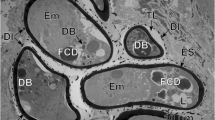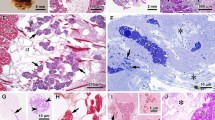Abstract
Large quantities of calcium carbonate crystals were present in the albumin gland of the reproductive system of the fresh-water snailPomacea paludosa. X-ray diffraction analyses indicated that they were vaterite. Scanning electron microscope observation of the albumin gland revealed that they occurred as spherules and were distributed throughout the gland. Vaterite spherules were present in the albumin gland ofPomacea urceus and the capsule gland ofPila virens. The mineral portion of the egg capsules was also vaterite. The egg capsule of these snails consisted of two morphologically distinct layers. Vaterite is less common in nature than the other two polymorphs of calcium carbonate, calcite and aragonite, and has not been recorded in the reproductive system of molluscs. It is interesting to note that in these snails calcium carbonate was present as vaterite both in the storage organ and fully differentiated egg capsule.
Similar content being viewed by others
References
Andrews, E. A.: The functional anatomy and histology of the reproductive system of some Pilid gastropod molluscs. Proc. Malac. Soc. Lond.36, 121–140 (1964)
Bahl, K. N.: On the reproductive processes and development ofPila globosa Part 1 Copulation and oviposition. Mem. Ind. Mus.9, 1–11 (1928)
Bayne, C. J.: Histochemical studies on the egg capsules of eight gastropod molluscs. Proc. Malac. Soc. Lond.38, 199–212 (1968)
Carlstrom, D.: Crystallographic study of vertebrate otoliths. Biol. Bull.125, 441–463 (1963)
Cohen, A. L., Marlow, D. P., Gainer, G. E.: A rapid critical point method using Fluorocarbon (Freons) as intermediate and transitional fluids. J. Microscopy7, 331–342 (1968)
Faivre, R., Wallaeys, R.: Sur les transformations de la vaterite nassaint au contact de sa liqueur-mere. C. R. Acad. Sci. (Paris)231, 285–287 (1950)
Gould, R. W.: Brown pelican eggshells: X-ray diffraction studies. Bull. environm. Contam. Toxicol.8, 84–88 (1972)
Hall, A., Taylor, J. D.: The occurrence of vaterite in gastropod egg shells. Mineral. Mag.38, 521–522 (1971)
Hawk, P. B., Osser, B. L., Summerson, W. H.: Practical physiological chemistry. New York: Blackston Co. 1954
Kessel, E.: Über die Schale vonViviparus viviparus L. andViviparus fasciatus Mull ein Beitrag zum Strukturproblem der Gastropodenschale. Z. Morph. Ökol. Tiere27, 129–198 (1933)
Lagergren, C.: Calcium carbonate precipitation in the pancreas, gallstones and urinary calculi. Acta chir. scand.124, 320–325 (1962)
Lowenstam, H. A.: Coexisting calcites and aragonites from skeletal carbonates of marine organisms and their strontium and magnesium content. In: Recent researches in the fields of hydrosphere, atmosphere and nuclear geochemistry (Miyake, Y., Koyama, T., Ed.). Tokyo: Maruzen Company 1964
Mayer, F. K., Weineck, E.: Die Verbreitung der Kalzium-Karbonate im Tierreich unter besonderer Berücksichtigung der Wirbellosen. Jena Z. Naturw.66, 199 (1932)
Meenakshi, V. R.: A quantitative study of the distribution of calcium in the soft parts ofPila virens. J. Zool. Soc. India7, 35–40 (1955)
Meier, W., Moenke, H.: Über die Natur der Kalziumcarbonate in Gallensteinen. Naturwissenschaften48, 521 (1961)
Meyer, H. J.: Struktur und Fehlordnung des Vaterits. Z. Krist.128, 183–212 (1969)
Prenant, M.: Les formes mineralogiques du calcaire chez les etres viviants et le probleme de leur determinisme. Biol. Rev.2, 365–393 (1927)
Prenant, M.: Contributions a létude cytologique du calcaire IV La vaterite chez les animaux. Bull. Biol.62, 21–50 (1928)
Saleuddin, A. S. M., Wilbur, K. M.: Shell regeneration inHelix pomatia. Canad. J. Zool.47, 51–53 (1969)
Saxena, B.: Ecology and behavior ofPila globosa. J. Bombay Natur. Hist. Soc.53, 733–736 (1956)
Schraer, H.: Biological calcification. New York: Appleton 1970
Sutor, J. D., Wooley, S. E.: Gallstones of unusual composition, Calcite, Aragonite and Vaterite. Science159, 1113–1114 (1968)
Wilbur, K. M.: Shell formation in molluscs. In: Chemical zoology, vol. VII, Mollusca (Florkin, M., Scheer, B. T., eds.), p. 103–143. New York: Academic Press 1972
Wilbur, K. M., Watabe, N.: Experimental study on calcification in molluscs and the algaCoccolithus huxleyi. Ann. N.Y. Acad. Sci.109, 82–112 (1963)
Author information
Authors and Affiliations
Rights and permissions
About this article
Cite this article
Meenakshi, V.R., Blackwelder, P.L. & Watabe, N. Studies on the formation of calcified egg-capsules of ampullarid snails. Calc. Tis Res. 16, 283–291 (1974). https://doi.org/10.1007/BF02008236
Received:
Accepted:
Issue Date:
DOI: https://doi.org/10.1007/BF02008236




